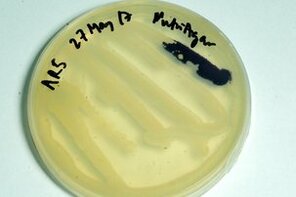


 A paper authored by lab member Andrew Rubio and published today in the journal Diseases of Aquatic Organisms investigates the possible role of the antifungal bacterium Janthinobacterium lividum in protecting high-elevation Andean water frogs of the genus Telmatobius. These frogs are highly susceptible to chytrid fungal infections, and populations of most species inhabiting cloud forest streams have sharply declined or have not been seen since the chytrid epizootics that occurred over the last two to three decades.  The bacterium Janthinobacterium lividum inhibits the growth of Bd on the host, reduces morbidity, and improves survival. It produces a purple compound, as seen in the picture here, which inhibits fungal growth. Despite the widely documented vulnerability of Telmatobius frogs to chytridiomycosis, populations of T. intermedius, T. marmoratus and other high-elevation species persist in southern and central Peru. These species inhabit streams and wetlands above the treeline, in open habitats exposed to sunlight during the day, so there could be multiple environmental factors contributing to population persistence. In this study, we wanted to investigate whether the presence of J. lividum in several populations of Telmatobius was correlated with prevalence and intensity of chytrid infection.  We sampled nearly 130 adult frogs for both chytrid and bacterium, and found that the probability of an individual being infected with the chytrid disease was independent of the presence of the protective bacterium. However, we did detect a protective effect of J. lividum with respect to intensity of infection. The wide distribution of J. lividum in the high Andes stands in stark contrast to its rarity in lower elevation cloud forest habitats, where most species of Telmatobius have disappeared.
0 Comments
Leave a Reply. |
Archives
June 2024
CATENAZZI LABNews from the lab Categories |